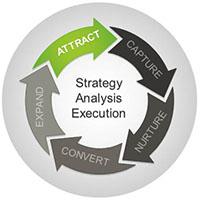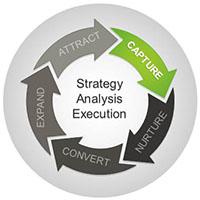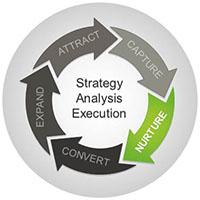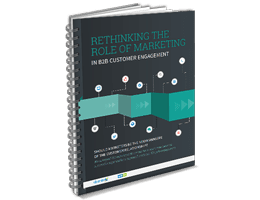 When you embark on a journey, a map is a handy thing to have, whether it’s a Google Map on your smart phone or the old-fashioned road map in your car. The same is true for the buyer’s journey, especially for B2B customers with a long and possibly complicated trip ahead of them. As marketers, it’s our job to help them get to their destination as quickly and painlessly as possible – to be their helpful tour guide. And to be good guides, we need to fully understand the journey each customer takes when they engage with our company.
When you embark on a journey, a map is a handy thing to have, whether it’s a Google Map on your smart phone or the old-fashioned road map in your car. The same is true for the buyer’s journey, especially for B2B customers with a long and possibly complicated trip ahead of them. As marketers, it’s our job to help them get to their destination as quickly and painlessly as possible – to be their helpful tour guide. And to be good guides, we need to fully understand the journey each customer takes when they engage with our company.
Stations Along the Way
The B2B customer journey is generally seen to have five stages: Attract, Capture, Nurture, Convert, and Expand. It’s also important to measure the movement through each stage and report on the results. Let’s take a look at the metrics that matter during each phase of the lifecycle.
Attract
In the beginning, the prospect is just starting to become aware of your brand. There are many different ways a new potential customer could find you, so it’s important to understand the channels they’ll use and the content they’ll be looking for, in order to move them along the process. Questions to  ask at this stage include:
ask at this stage include:
- Which channels are being used?
- What content is being consumed?
- How many people consumed the content?
- How often do content consumers share content?
Your goal is to increase visibility, and grow your audience with more impressions and deeper conversations.
Learn essential ways to use content to attract top-of-funnel leads, with our eBook “Attraction 101: Content Marketing.”
Capture
Once you’ve attracted the attention of a potential customer, the next step is to find out who they are and what they want so you can start a  conversation that speaks to their interests. Questions to ask here include:
conversation that speaks to their interests. Questions to ask here include:
- How many content consumers became known visitors?
- What calls to action are most effective? With which audiences?
- Which channels are most effective?
The goal here is to increase the number of known prospects in the funnel and gain as much insight about them as possible.
Nurture
Nurturing can be defined as building a relationship with a prospect through a series of timed touches designed to help them move through the buyer’s  journey, and to keep your brand top of mind. Segmentation, lead scoring, triggered campaigns, and automated programs are all proven lead nurturing tactics. Questions to ask at this stage might be:
journey, and to keep your brand top of mind. Segmentation, lead scoring, triggered campaigns, and automated programs are all proven lead nurturing tactics. Questions to ask at this stage might be:
- How many Marketing Qualified Leads are generated?
- Which automated programs are most effective?
- What’s driving up lead scores?
By nurturing leads, you can make sure they’re ready to buy when the time comes. Plus, nurtured leads make 47% larger purchases than non-nurtured leads, according to The Annuitas Group.
Download this comprehensive eBook, “10 Ways to Nurture the Buyer’s Journey” to learn 10 tactics to build a successful lead nurturing campaign in today’s inbound, multichannel, custom-tailored B2B marketing world.
Convert
This can be either the conversion of a lead to an opportunity, or an opportunity to a sale. In the later stages of the process, it boils down to a win – the  customer chooses your solution or goes to a competitor. You may also face the dreaded “no decision,” which happens in as many as 26% of deals, according to CSO Insights. Here are the questions to ask at this stage:
customer chooses your solution or goes to a competitor. You may also face the dreaded “no decision,” which happens in as many as 26% of deals, according to CSO Insights. Here are the questions to ask at this stage:
- How many Sales Qualified Leads are generated?
- Which campaigns are most effective at closing opportunities?
- How often do content consumers turn into customers?
The goal is to create higher quality leads at less cost per lead and less cost per customer.
Expand
Once the prospect becomes a customer, the journey’s not over – or at least it shouldn’t be. Creating a deeper relationship with customers is key to more efficient revenue growth. Key questions include:
revenue growth. Key questions include:
- How many resells, upsells, and cross-sells are generated?
- What customer marketing campaigns and programs are most effective?
- How often do customers turn into repeat customers?
- Which loyalty programs are driving the best results?
- How much revenue is driven from existing customers?
Building relationships with existing customers does more than help increase their lifetime value – it can also turn them into evangelists who recommend your brand to others. According to Ken Krogue of InsideSales, leads that come from referrals are worth 4X as much as leads from your website, and 36X as much as a lead generated from a cold call.
Finding a Leader
So who is the tour guide for the customer journey in your organization? Most marketing, sales, and services teams see customer lifecycle engagement as a series of overlapping steps. Marketing leads some steps and is a key contributor to others. The passage from nurturing (marketing-led) to conversion (sales-led) is managed through an agreed-on set of reciprocal responsibilities, creating sales and marketing alignment. The expansion stage is managed through an agreed-on set of reciprocal steps among sales, service, and marketing.
 The recent report from Gleanster and Act-on, Rethinking the Role of Marketing, demonstrated that marketing teams have traditionally focused their time and money on only one part of the journey – customer acquisition. But now, marketers in top performing companies are becoming the new managers of the customer relationship throughout the lifecycle – including customer retention and expansion.
The recent report from Gleanster and Act-on, Rethinking the Role of Marketing, demonstrated that marketing teams have traditionally focused their time and money on only one part of the journey – customer acquisition. But now, marketers in top performing companies are becoming the new managers of the customer relationship throughout the lifecycle – including customer retention and expansion.
Of course, that’s in top performing companies. Many average marketing teams just aren’t there yet. But in order to make sure someone is serving as the cruise director on the customer’s voyage, it’s first necessary to map that journey out, and make sure there’s accountability for every leg of the trip – as well as the transfers from one station to the next.
 According to the companion eBook to the report, Marketing: The New Stewards of the Customer Relationship, there are four steps to closing the gaps when it comes to creating a customer journey map:
According to the companion eBook to the report, Marketing: The New Stewards of the Customer Relationship, there are four steps to closing the gaps when it comes to creating a customer journey map:
- Identify who owns which aspect of the buyer’s journey and the role each department plays.
- Align those roles to each other and to the buyer’s journey.
- Consider creating a three-way Service Level Agreement to help each department identify which portion of the journey they own, and how they will cooperate with the others.
- Audit and evaluate your existing content – tools, case studies, solution briefs, white papers, videos, demos, webinars, etc. – based on which persona it addresses, which questions it answers, and which stage of the buying process it will serve.
There’s also a template that you can use to create your own Customer Lifecycle Accountability Matrix. Check it out, and see if it can help you identify some of the gaps in accountability throughout the journey.
After all, customers should feel like they’re on an adventure, not locked into an unstoppable assembly line. A good customer journey map – one that changes, reorients, and recalculates a new route on the fly based on what the prospect says or does during the trip – can make your customers feel like they’re traveling first class all the way.
